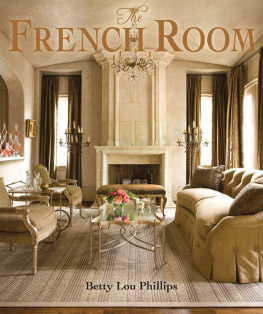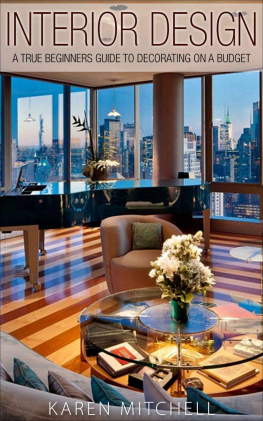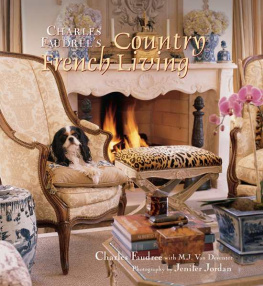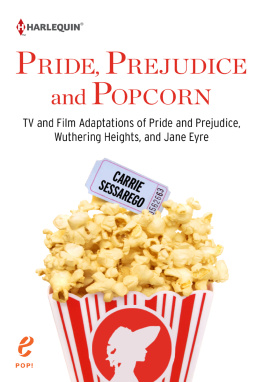For everyone who loves books and homes and homes in books


INTRODUCTION
The idea for this book came to me one evening while I was doing something that I am often doing: sitting on my couch with my dog, Millie, watching a movie and drinking a Manhattan. On this particular evening, I was watching the 1997 Jane Eyre starring Samantha Morton and Ciarn Hinds. This is only one of several Jane Eyre adaptations that I return to again and again rather than actually watching anything new. It was February and cold and gloomy outsideperfect Jane Eyre weather. How could I watch anything else?
Like other Jane Eyre films, this one features a great Thornfield Hall. The exterior is Naworth Castle in Cumbria, and the interior is Knebworth House in Hertfordshire. This composite Thornfield is gloomy, dark, and Gothic in the extreme, as it should be. As I watched Mortons Jane Eyre adjust to her new surroundings, another interest of mine popped into my head: the world of home decorating and design. I started to notice things like the candlesticks, the chairs, and the rugs. The art on the walls. The fireplace and the mantel. I wouldnt mind a rug like that, I thought. All nice and worn down. And so Thornfield Hall became an accidental decorating inspiration, an idea that struck me as darkly funny, given the tragedies and horrors that the house holds. I grabbed my laptop and started to take notes while I watched the movie. What if Jane were interested in paint colors and cushions? Maybe scorched-by-a-fire-set-by-your-husbands-doomed-secret-wife is the new shabby chic.
I was no stranger to the world of home-design sites and blogs, as my house had been featured as an Apartment Therapy House Tour a year earlier. I had lived in the small city of Winston-Salem, North Carolina for about four years, first renting a unit in a larger house and then moving into a duplex. I moved out of the duplex in 2012 to undertake a one-year research sabbatical, which took me to New York City, Washington, DC, and Pasadena, and when I came back through town on my drive from New York to California, I spotted a house for sale in the same old, historic neighborhood I had lived in before. It was quite cute. It was also cheap. I hadnt thought about buying a house, but no one had made an offer on this one, perhaps because it needed some workreally just a fresh coat of paint and some landscaping. It was a 1920s shingled house, two stories and two thousand square feet: quite luxurious for one person and her pooch. So I bought it. And named her Maud because she was an old dame. And then I got to work settling in. I had loved decorating my other places in Winston-Salem, as well as my prewar, fourth-floor walk-up apartment in Morningside Heights in New York City, where I had lived during graduate school, but now I could do things like paint the walls. Even paint them dark colors. This was too exciting for words. When everything was in order, I submitted it to Apartment Therapy, and a writer named Tamara Gavin came from Asheville to interview me and take pictures. We talked about the house and had barbecue for lunch. It was a lot of fun.
Once I had written my Jane Eyre House Tour, I knew where I wanted to send it: the Toast. I had written a few essays for the site and admired its combination of wit and intelligence. My editor, Nicole Chung, liked the idea and accepted it, and Great House Therapy was born. I was fortunate to write for the Toast as the site succeeded in doing something almost unheard of on the Internet, particularly for women writers who are accustomed to online harassment: It created a supportive and vibrant community of writers and readers. When I started writing non-academically several years ago, I was told by writer friends never to read the comments. In general, Ive been pretty good about this, and when Im tempted, a quick glance is enough to remind me of the wisdom of this advice. The Toast is the only site I have written for where not only did I read the comments, I looked forward to reading the comments. It was a genuine pleasure to go through readers posts. Being an English professor can be an isolating job. I was happy for the sense of camaraderie that I found with the Toast. Now the Toast is no more, but its spirit remains. Even as I write this, I find that Im smiling.
I wrote eight more columns for Nicole, choosing novels and plays that I often taught at Wake Forest University and others that I just thought would be a kick. Still others were childhood classics that I wanted to revisit. These homes tell us about characters. They tell us about communities. And they tell us about the past. You cant think about Pride and Prejudice without thinking about Pemberley. In fact, Elizabeth cant think about Darcy without it; she falls in love with him when she sees his house. From the landscape in which it is set to its interiorand the portrait of Darcy that she admiresPemberley reveals the real Darcy, not the version of the towns gossip or even the version that Darcy himself (badly) performs. When I teach Hamlet, we always talk about Elsinore. Shakespeares stage has been called a bare stage. The outdoor London amphitheaters where his plays were often performed did not have setsor not what we think of as sets today. The audience had to imagine Elsinore, as the chorus of Henry V asked them to imagine the horses and armies of the battle of Agincourt at the beginning of that play. These things could not be presented; they had to be conjured. Elsinore is the place to which the ghost of King Hamlet returns. It is the place where Ophelia is buried. It is the place where Hamlet and Laertes engage in a fencing match to entertain the court. It is a place of surveillance: Everyone is watching everyone else. It has a character all its own. It is an entrapping place. Ensnaring. Corrupt. Dangerous. Rotten.
But in working on this book, I also had the opportunity to explore literary homes that were less familiar. This was particularly true of the classics that I hadnt reread since I was a younger: books like Anne of Green Gables, The Swiss Family Robinson, and Pippi Longstocking. Anne of Green Gables still has the power to charm. Along with Little Women, it will always be one of the books that made me want to be bookish. To teach. To write. Other classics have aged less well. Pippi Longstocking, which I remember as an incredible fantasy of childhood independence (who needs parents?), is a racist disaster. And then of course there is always the question of gender, particularly when youre writing about homes, which have traditionally been a female domain. When I watched the 1960 Disney film Swiss Family Robinson as a kid, the tree house made quite an impression. I wanted that tree house. In the book, the house is the mothers idea, and the father is resistant; she has to convince him that her plan will work. But in the film, the house is the fathers ideaa surprise for his wifeand she is so overwhelmed by his generosity that she professes she does not deserve it. The film is a glossy, terrifying reimagining of the book: The hardworking husband provides for his beautiful, good, passive wife, even on a deserted island. The dcor has a distinctly mid-century vibe, and he even builds a dream kitchen, just like those spaces back home where suburban wives whiled away the hours after World War II. There is an icebox that is clearly a refrigerator: not something Johann David Wyss had in mind in 1812. It is fun to mock the sexism of some classics; it feels like resistance. And some books are so over-the-top that they already seem like satire. That was my sense in revisiting
Next page











